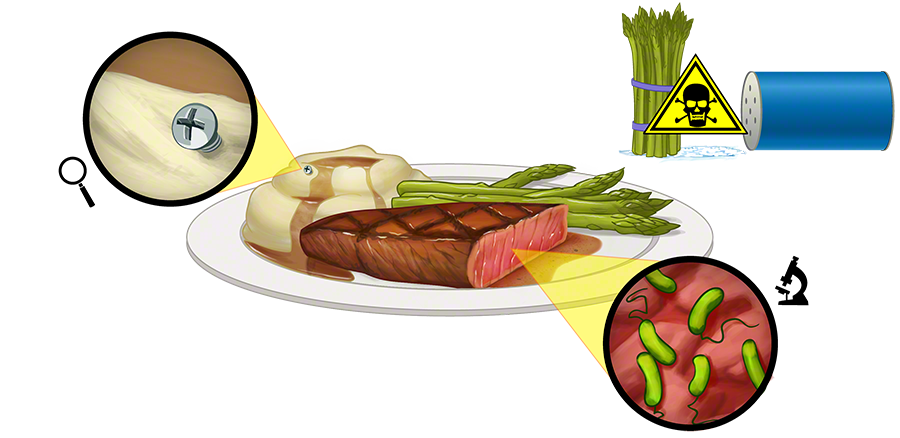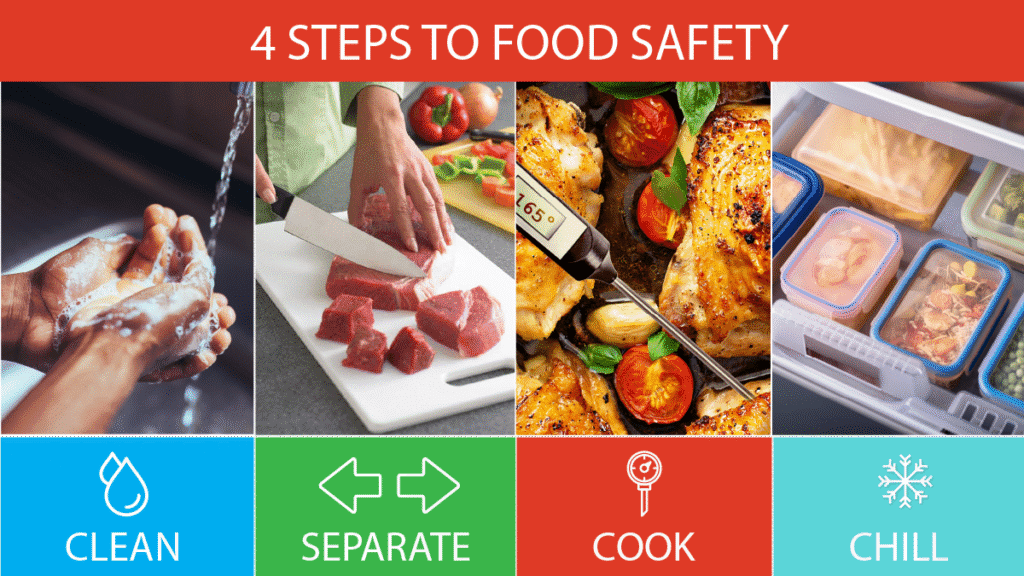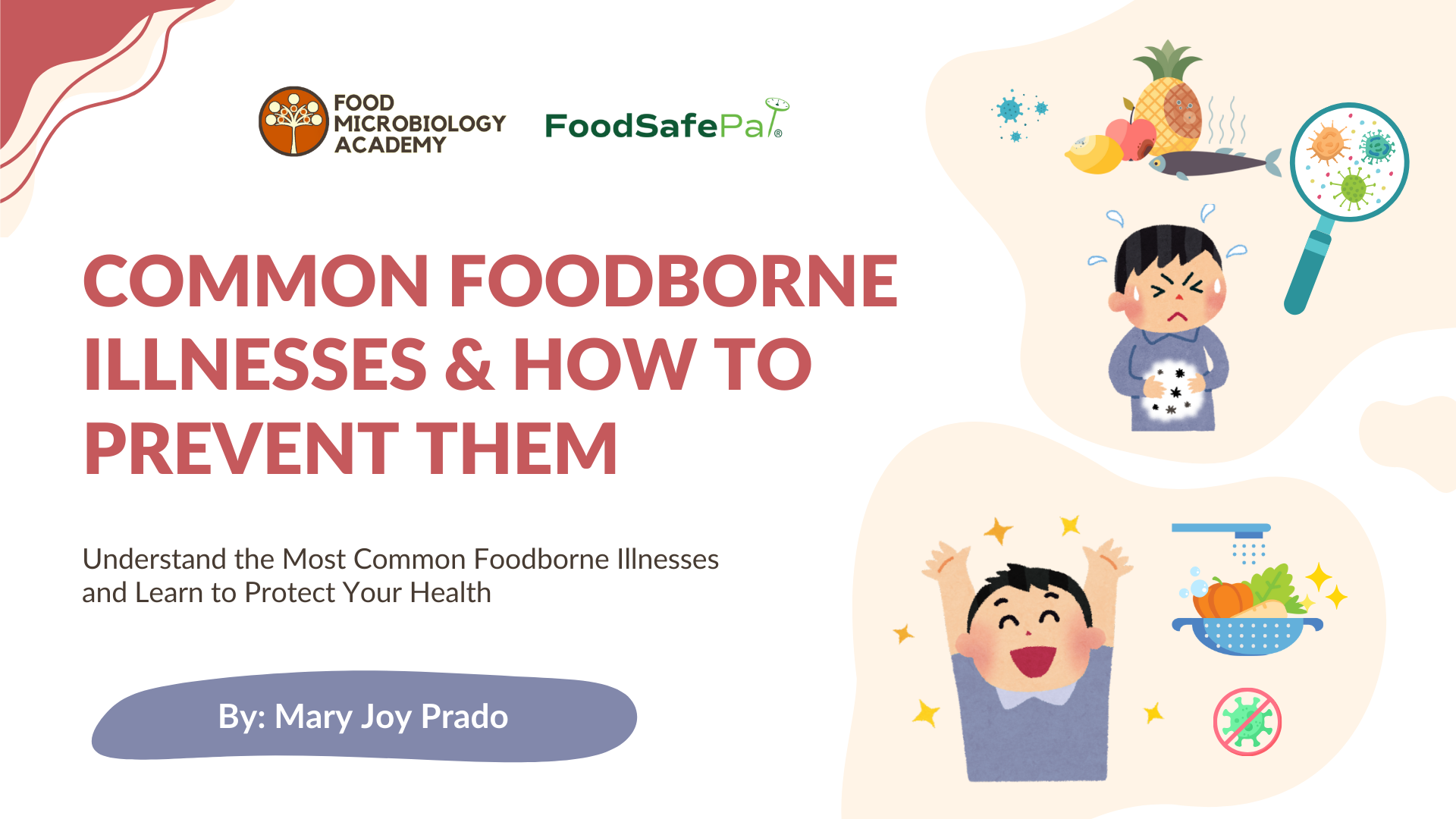Have you ever felt stomach pain? Not because you skipped meals or ate too quickly, but because you trusted that the food served was safe to eat? Unfortunately, many people fall ill from food—food that was supposed to nourish us, provide energy, and bring joy. A single meal, when mishandled or improperly prepared at home or even in a restaurant, can cause more than just discomfort. In severe cases, it can lead to long-term health complications or even death.
Food safety is something many people take for granted until an outbreak makes the news. Beyond the immediate health risks, foodborne illnesses also carry economic and social costs. Families may face expensive hospital bills, businesses can lose consumer trust, and workers often miss days of school or employment due to sickness.
According to the Centers for Disease Control and Prevention (CDC) each year 48 million illnesses, 128,000 hospitalizations, and 3,000 deaths in this country can be attributed due to foodborne pathogens. These statistics highlight that food safety is not merely a kitchen concern or a matter of personal hygiene. In fact, it is also a public health and economic concern that affects families, communities, and economies worldwide.
The good news is that most of these illnesses are preventable. With proper knowledge of how to handle, prepare, and store food, we can greatly reduce the risks. From practicing simple habits at home—like handwashing and cooking food thoroughly—to strengthening food systems and regulations, every effort matters. Food safety begins with education that leads to action. By understanding why it is so important, we can protect ourselves, those we care about, and most especially the people around us.
I Wanna Know: What are Foodborne Illnesses?
Foodborne illnesses, also known as food poisoning, happens when a person consumes a contaminated food or beverage. According to the World Health Organization (WHO), a total of 600 million cases of foodborne illnesses and 420,000 deaths are recorded every year worldwide. It was revealed that 30% of foodborne deaths occur among children under 5 years of age. Moreover, each year, eating unsafe food takes away around 33 million years of healthy living worldwide—and experts believe the real number could be even higher.

Photo from: https://www.statefoodsafety.com/Resources/Resources/training-tip-understanding-food-hazards
Foodborne illnesses occur when a hazard enters your food or drink, making it unsafe to consume. These hazards can be chemical, physical, or biological. Chemical hazards are particularly concerning because they can come from different sources in the environment. Some occur naturally, like lectin in beans or algal toxins in seafood. Others are intentionally added, such as food additives, dyes, pesticides, or veterinary drugs used in farming. Still others may be introduced unintentionally, for example through cleaning agents or environmental chemicals.
Physical contamination happens when foreign objects end up in food, posing risks of illness or injury to consumers. These objects can come from the environment, such as stones mixed in during harvesting or from poorly maintained equipment and storage areas. They may also enter food during processing, with common examples including glass, plastic, or wood fragments—often the result of inadequate cleaning or maintenance. In some cases, contamination occurs due to human factors, such as untrained staff, carelessness, or wearing unsuitable clothing in food-handling areas. When consumed, this may lead to wounds and choking.
In this blog, we’ll be focusing on biological hazards, or microbiological organisms, which include bacteria, viruses, fungi, and parasites. These tiny yet powerful agents are the leading cause of foodborne illnesses in humans and are responsible for most reported cases worldwide. For example, a recent multistate Salmonella outbreak in California affected 95 people. Investigations revealed that the source was traced to Country Eggs LLC, which had distributed large, brown cage-free eggs—marketed as “sunshine yolks” and “omega-3 golden yolks”—under the brand names Nagatoshi Produce, Misuho, and Nijiya Markets. According to Dr.Monica Gandhi, an infectious disease expert at UC San Francisco, there’s an urgent need to provide the CDC with proper funding so it can effectively respond to outbreaks.
Don’t Get Sick: Understanding the Most Common Foodborne Illnesses
To better understand the risks, let’s look at some of the most common foodborne illnesses that affect millions of people each year.
- Norovirus (Stomach Flu or Stomach Bug)
- One of the most common causes of foodborne illness. It causes acute gastroenteritis or inflammation of the stomach or intestines.
- It spreads very easily, not only through contaminated food and water but also from person-to-person.
- Symptoms: Vomiting, diarrhea, stomach cramps, headache, muscle aches, and sometimes a mild fever. Symptoms usually appear within 1–2 days after infection.
- Risks: Dehydration is the biggest concern, especially for children and the elderly.
- High-risk foods: Raw or undercooked shellfish, particularly oysters.
- Hepatitis A
- Unlike many other foodborne illnesses, Hepatitis A affects the liver. It can spread through contaminated food or water, but also through close personal contact. Certain groups, like people who use drugs, men who have sex with men (MSM), and those experiencing homelessness, are more vulnerable.
- Symptoms: Yellowing of the skin (jaundice), dark urine, fever, loss of appetite, diarrhea, and stomach pain. Symptoms usually appear 2–7 weeks after exposure and can last up to 2 months.
- High-risk foods: Raw or undercooked shellfish.
- It is highly encouraged to get vaccinated.
- Salmonella
- Salmonella is a major cause of food poisoning worldwide and can lead to serious complications. It spreads through contaminated food, water, and direct contact with animals or their environment.
- Symptoms: Diarrhea, stomach cramps, fever, nausea, and vomiting. Symptoms can start 6 hours to 6 days after infection and last about a week.
- High-risk foods: Undercooked meat, poultry, and eggs.
- E.Coli
- It helps us digest food, produce vitamins, and protect from harmful germs.
- Symptoms: Severe stomach cramps, watery or bloody diarrhea, nausea, and vomiting. Children under 5 are at higher risk because their immune systems are still developing.
- High-risk foods: Undercooked ground meat, raw produce, and contaminated water.
- It is recommended to drink plenty of fluids and take anti-diarrheal medication upon doctor’s prescription.
Read more here: https://foodsafepal.com/foodborne-illnesses/

Photo from: https://www.cdc.gov/food-safety/prevention/index.html
As mentioned above, foodborne illnesses can be prevented. Here are some reminders to keep you safe:
- Wash your hands with soap and water before handling food, after using the bathroom, or after touching pets.
- Cook food thoroughly—especially meat, poultry, seafood, and eggs. Use a food thermometer if possible to check safe internal temperatures.
- Avoid cross-contamination by keeping raw meat separate from fruits, vegetables, and cooked food. Always use different cutting boards and knives.
- Store food safely by refrigerating perishables within two hours (or within one hour if it’s very hot outside). Keep your fridge at 4°C (40°F) or below.
- Use safe and clean water and raw materials by washing produce properly.
- Get vaccinated against hepatitis A and typhoid fever.
- Remember F.A.T.T.O.M that contributes to microbial growth.
- Food
- Acid
- Temperature
- Time
- Oxygen
- Moisture
Be Wise: A Call to Action
Although foodborne illnesses can affect anyone, some groups are more vulnerable to getting very sick from contaminated food or drinks. These include pregnant individuals, young children under 5 years old, adults aged 65 and older, and people with weakened immune systems due to conditions like diabetes, cancer, or other chronic illnesses. International travelers are also at higher risk, especially when visiting places where food and water safety standards may differ. For these groups, taking extra precautions in food handling, preparation, and consumption is important to reduce the risk of foodborne illnesses.
From a public health perspective, food safety is not just about individual choices. It is also about collective responsibility. While careful and informed actions at the individual level, such as proper handwashing and safe food handling, can greatly reduce risks, broader systemic efforts are equally important.
The World Health Organization (WHO) leads efforts to strengthen food safety worldwide by promoting investment, coordinating across sectors, and equipping consumers with tools to make safer choices. Yet, food safety often receives little political attention, especially in developing countries. This is why having reliable data on how many people are affected is so important—it helps raise awareness, get the support of leaders, and secure resources to build stronger systems that can protect everyone from unsafe food.
According to the Centers for Disease Control’s (CDC) Morbidity and Mortality Weekly Report (MMWR), inadequate food temperatures and improper cooling were major contributors to bacterial outbreaks. During the pandemic, underreporting occurred due to limited public health resources with sick food workers playing a role in contamination.
Moving forward, individuals are encouraged to practice proper handwashing, cooking food thoroughly, avoiding cross-contamination, and storing food safely. Eventually, making these practices a habit. In this way, we can protect ourselves and others from unnecessary risks. Remember, food safety is also a communal responsibility that helps keep families, workplaces, and entire communities healthier. Aside from this, there is a need to strengthen food safety through better surveillance, workforce training, and thorough outbreak investigations.
If you want to take your food safety knowledge to the next level, consider getting certified. FoodSafePal offers official Food Handler and Food Manager Training that’s fast, easy, and fully approved. Plus, you can save on your certification by using our code foodsafety1 at checkout. Taking this step not only sharpens your skills but also helps build a culture of safe food practices everywhere.
Risky! Risky! Foodborne illnesses are emergencies with inadequate handling. Be wise in choosing, preparing, and storing your food.



